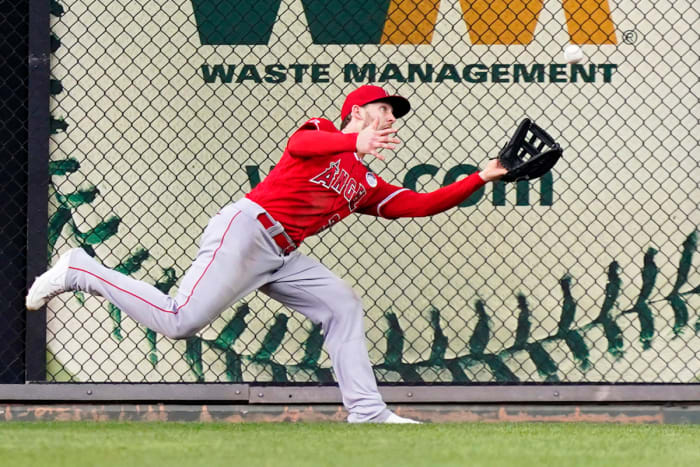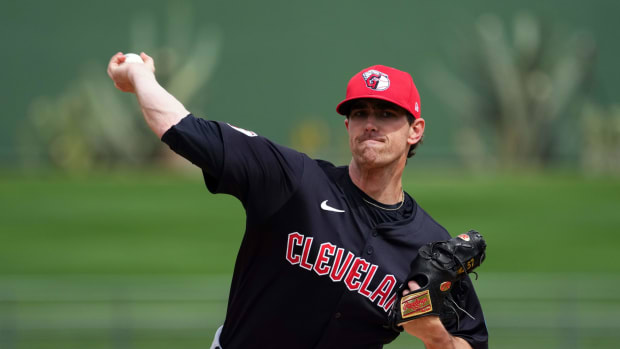Inside Angels Right Fielder Taylor Ward’s Emergence as One of MLB’s Best Players
Welcome to The Opener, where every weekday morning during the regular season you’ll get a fresh, topical story to start your day from one of SI.com’s MLB writers.
Lou Marson remembers the first time he saw Taylor Ward playing out of position.
It was 2018, and Marson—a former big-league catcher who’s currently in his fourth season as the manager of the Angels’ Triple-A affiliate, the Salt Lake Bees—was managing the Double-A squad at the time, the Mobile BayBears. It was then that the organization decided it was time to find Ward a new position. The 2015 first-round pick had played catcher almost exclusively from his freshman year at Fresno State through his first three years in the minors. Now, the Angels wanted to try him out at third base.
As Marson recalls, Ward’s acclimation to his new defensive home wasn’t quite like a duck to water.
“That was not good,” Marson says with a laugh. “Honestly, I felt bad for him at third … He wasn’t a fan of it at first. They said, ‘Hey, we want you to move to third base, no more catching.’ He took it hard. I remember he was on the back fields in Tempe Diablo [Stadium], and he took a ground ball at third off the face somewhere, and then he was out for a little bit. That was his first taste of playing third base.”
Fast forward four years, and Ward is happy to put his days in the infield behind him. Now a right fielder, he’s not only found his new defensive home, but he’s established himself as one of the league’s best hitters in what’s been a surprise breakout season seven years in the making.

Ward attributes his emergence at the plate to a key mechanical change. He keeps his bat at a 90-degree angle relative to his spine before he starts his swing.
Brian Fluharty/USA TODAY Sports
As the Angels jumped out to their best start in years, it was Ward who was leading the offensive charge. Through May 24, the team was 27–17, with Ward setting the table for what was then the American League’s highest-scoring offense. The 28-year-old was hitting a scorching .370/.481/.713 at that time, leading the majors with a 237 wRC+ among hitters with at least 130 plate appearances.
It’s no coincidence that the team’s franchise-record 14-game losing streak that began on May 25 occurred as Ward was mostly sidelined with shoulder and hamstring injuries. Between his injuries, he went 4-for-24 (.167) in the eight games he played during the streak.
Now, with the Angels sitting at 29–33 and 8.5 games behind the Astros in the AL West, Ward is expected to make his long anticipated return to the active roster for the start of a two-game series on the road against the Dodgers on Tuesday. If the Halos are going to turn things around after the worst stretch in team history, they’ll need Ward to play like he did over the first month and a half of the season, when he unexpectedly emerged as one of the league’s best hitters.
The foundation for Ward’s out-of-nowhere breakthrough was laid on those back fields in Tempe. He credits his offensive gains to key changes in his swing mechanics, though the results started to shine through almost immediately after he transitioned away from being a catcher.
From 2015 to ’17, Ward exclusively caught in the minor leagues, and posted respectable (if not eye-popping) numbers. Across four levels and over 1,100 plate appearances, Ward had a .272/.366/.375 slash line with 22 home runs—a serviceable output from a catcher, to be sure, but the physical and mental strain of playing the position was a lot to deal with.
“I remember watching him catch, and for me, watching him, it took him a while to process what pitch he wanted to call,” says Marson, who caught over 2,000 innings during his six-year MLB career. “I remember after every pitch, he’d be taking his mask off, and the pace of play when he was back there behind the plate wasn’t great. Just getting that burden off of him, it’s a lot. There’s a lot of information, especially at the major league level now, that you need to know as a catcher. It’s been great for him, getting him to the outfield. It’s career-changing, for sure.”
Ward spent all of the 2018 season at third base, and, coincidence or not, his batting blossomed with the move. Ward hit .349/.446/.531 in 102 games across Double and Triple A, eventually earning his first big-league call-up. Though his first exposure to the majors didn’t produce much (he hit .190 in 147 plate appearances), his move away from catcher—coupled with key adjustments to his swing—paved the way for the hitter he’s become today.
“When I made a big overhaul in my [hitting] mechanics was when they switched me [from catcher], so I never was able to actually catch and hit the way I’ve been hitting [now],” Ward says. “I’m not really sure how that would have worked out if I was still a catcher. I want to say I still would have had a lot more success with the mechanical change. But physically, being a catcher, how grueling it is … it would have been interesting to see how that would have maintained strength over the years if I was still catching.”
The biggest change to his swing, Ward explains, is something he calls early connection, and a key component has been keeping his bat at a 90-degree angle relative to his spine before he starts his swing. That enables him to match his bat path to the plane of the incoming pitch, which increases his chances of making solid contact with the ball even if his timing is a tad off.
“And then, when I’m on time, that’s where doubles and homers come from,” Ward says.
Ward again raked in the minors in 2019, though this time at another new position: left field. He still played third sometimes, and even first base and right field, though his eventual permanent switch to the outfield was underway.
Seeing the speedy Ward patrol right field now, it seems obvious that the outfield was his most natural position. His average sprint speed of 28.2 feet per second ranks in the 78th percentile of all hitters, and he ranks eighth in outs above average (per Statcast) among qualified right fielders despite appearing in only 38 games.

Ward’s speed, range and arm make him much better suited to play right field than catcher.
AP Photo/Matt Slocum
But if Ward looks like a natural out there now, that wasn’t the case when he was still grinding in the minors as a defensive nomad.
“It actually kind of makes sense, looking at it now,” Angels first baseman Jared Walsh says. “He’s got a cannon, great arm, and he moves so well that—I don’t want to say it’s a waste to have him behind the plate, but he’s an exceptional athlete.
“It’s been so cool to watch him, because he started playing the outfield some in 2019 when we were in Triple A. Just seeing the outfielder he was to what he’s become now, I think that’s a testament to how hard he works and how confident of a player he is. Every facet of his game, he continues to improve.”
Ward’s maturation from a decent hitter without a position to an All-Star-caliber outfielder has been a boon for the Angels. After years of bouncing around the diamond and getting sent up and down from the minor leagues, Ward now takes comfort in knowing that his spot in the lineup is secure, freeing his mind to focus on keeping his new and improved swing in rhythm.
“I think the biggest thing is knowing that that’s my spot now. Like, that’s mine, now people have to take it from me,” Ward said. “I think that’s the biggest thing that’s really helped kind of secure things. But the transition from catcher to third to left to first, they’re all learning moments, you know? I kind of just take bits and pieces here and there and try and get better.”
More MLB Coverage:
• Don’t Underestimate Jose Ramirez and the Guardians
• Manny Machado Is Letting His Play Do the Talking
• Five-Tool Newsletter: Tony La Russa’s Latest Illogical Decision
• How Concerned Should We Be About These Struggling All-Stars?


































